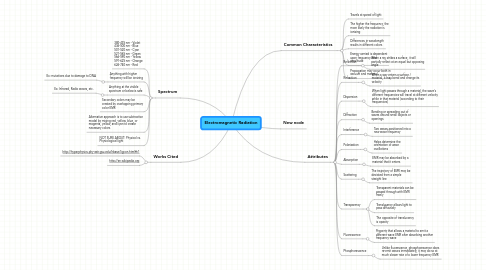
1. Spectrum
1.1. 380-435 nm - Violet 436-500 nm - Blue 501-520 nm - Cyan 521-565 nm - Green 566-590 nm - Yellow 591-625 nm - Orange 626-740 nm - Red
1.2. Anything with higher frequency will be ionizing
1.2.1. Ex: mutations due to damage to DNA
1.3. Anything at the visible spectrum or below is safe
1.3.1. Ex: Infrared, Radio waves, etc.
1.4. Secondary colors may be created by overlapping primary color EMR
1.5. Alternative approach is to use subtractive model by mixing red, yellow, blue, or magenta, yellow, and cyan to create necessary colors
1.6. NOT SURE ABOUT: Physical vs. Physiological light
2. Works Cited
2.1. http://hyperphysics.phy-astr.gsu.edu/hbase/ligcon.html#c1
2.2. http://en.wikipedia.org
3. Common Characteristics
3.1. Travels at speed of light
3.2. The higher the frequency, the more likely the radiation is ionizing
3.3. Differences in wavelength results in different colors
3.4. Energy carried is dependent upon frequency and amplitude
3.5. Propagation may occur both in vacuum and material
4. Attributes
4.1. Reflection
4.1.1. When a ray strikes a surface, it will partially reflect at an equal but opposing angle
4.2. Refraction
4.2.1. When a way enters a surface / material, it may bend and change its velocity
4.3. Dispersion
4.3.1. When light passes through a material, the wave's different frequencies will travel at different velocity while in that material (according to their frequencies)
4.4. Diffraction
4.4.1. Bending or spreading out of waves around small objects or openings
4.5. Interference
4.5.1. Two waves positioned into a new wave frequency
4.6. Polarization
4.6.1. Helps determine the orientation of wave oscillations
4.7. Absorption
4.7.1. EMR may be absorbed by a material that it enters
4.8. Scattering
4.8.1. The trajectory of EMR may be deviated from a simple straight line
4.9. Transparency
4.9.1. Transparent materials can be passed through with EMR freely
4.9.2. Translucency allows light to pass diffusively
4.9.3. The opposite of translucency is opacity
4.10. Fluorescence
4.10.1. Property that allows a material to emit a different wave EMR after absorbing another frequency wave
4.11. Phosphorescence
4.11.1. Unlike fluorescence, phosphorescence does re-emit waves immediately, it may do so at much slower rate of a lower frequency EMR
